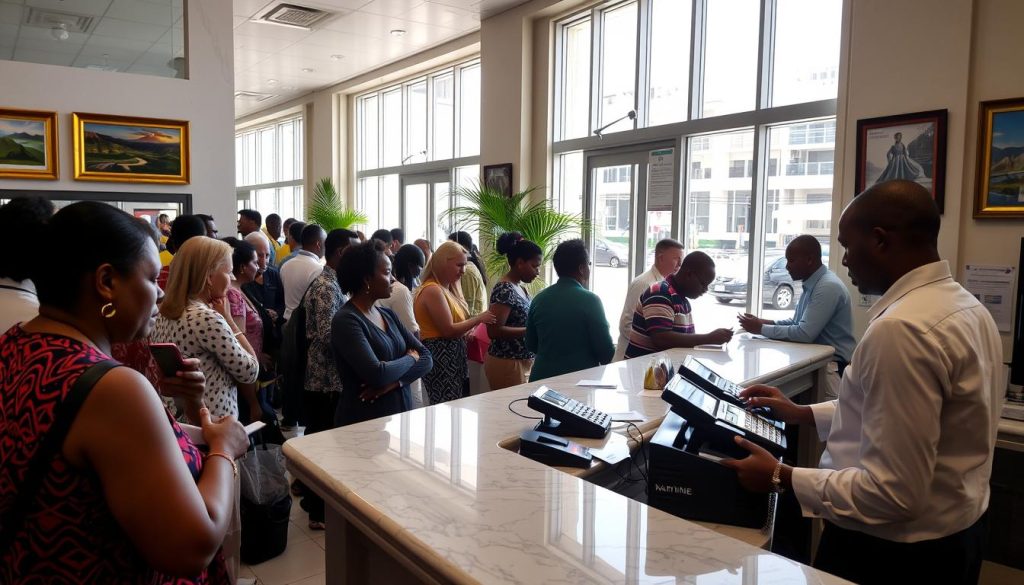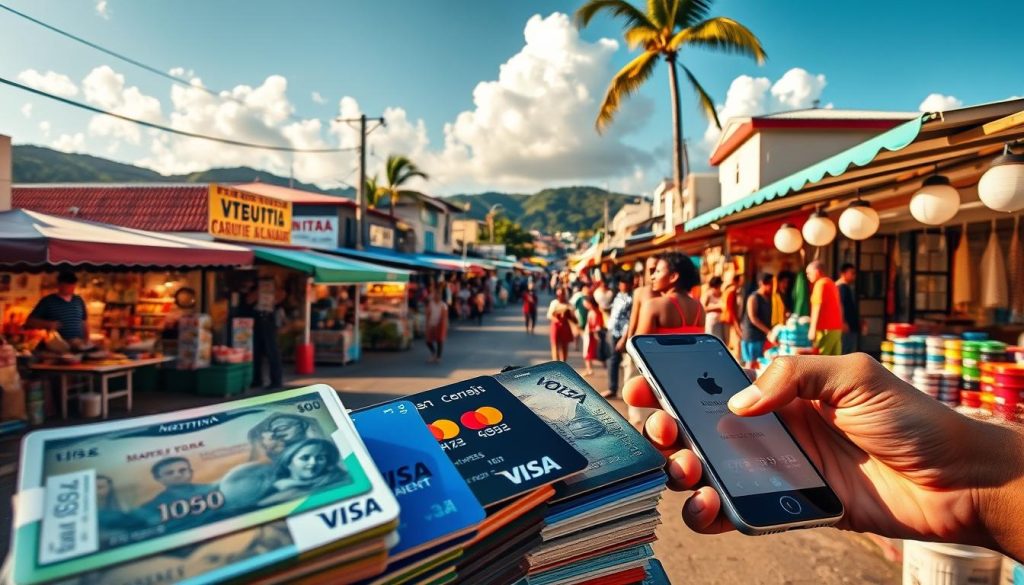✓ Accommodations✓ Flights✓ Rental Cars✓ Tours & Activities
Did you know that Martinique, a stunning Caribbean island, uses the euro as its official currency? This might surprise many travelers from the United States, who often expect to use US dollars abroad. Understanding the local money system is key to a smooth trip.
Whether you’re exploring Fort-de-France or relaxing on the beaches, knowing how to manage your currency is essential. Credit cards, ATMs, and traveler’s cheques are widely accepted, making it easy to access your funds. This guide will help you navigate payments and ensure you’re prepared for your adventure.
From banking hours to tips on getting the best exchange rates, we’ve got all the information you need. Let’s make your travel experience seamless and stress-free!
Understanding Martinique’s Currency Landscape
When visiting the Caribbean, understanding the local currency is crucial for a hassle-free experience. The euro is the official legal tender, making it the primary form of money for all transactions. This ensures consistency and ease for both locals and visitors.
While the euro dominates, some businesses may accept US dollars, especially in tourist-heavy areas. However, it’s wise to carry euros for most purchases. Foreign currencies are not widely used, and exchange rates may not be favorable.
Foreign Currency Acceptance and Regulations
If you’re bringing cash, be aware of import/export regulations. Amounts exceeding €10,000 must be declared upon entry or exit. This requirement helps prevent illegal activities and ensures transparency.
For convenience, ATMs are widely available, and credit cards are accepted at most establishments. Traveler’s cheques are also an option, though less common. Having multiple payment methods ensures you’re prepared for any situation.
With this information, you can confidently manage your money and focus on enjoying your travel experience. Understanding these details will make your trip smoother and more enjoyable.
Martinique: Ultimate Travelers Guide to Currencies & Payments
Planning your trip to this Caribbean gem? Knowing the local currency is your first step. The euro is the official currency, ensuring consistency across the island. While some tourist spots may accept US dollars, it’s best to carry euros for most transactions.
Seasonal changes and regional differences can impact exchange practices. During peak travel seasons, exchange rates may fluctuate, so it’s wise to monitor them closely. In less touristy areas, cash is often preferred over cards.

Managing your money effectively is key to a smooth travel experience. ATMs are widely available, and credit cards are accepted at most establishments. For added convenience, consider using prepaid travel cards or mobile payment apps.
This guide is built on up-to-date information from trusted sources. Whether you’re exploring bustling cities or serene beaches, these tips will help you navigate payments with ease. Here’s a quick overview of the island’s payment practices:
| Payment Method | Acceptance | Best For |
|---|---|---|
| Cash (Euros) | Widely accepted | Small purchases, rural areas |
| Credit Cards | Most establishments | Hotels, restaurants, shops |
| Mobile Payments | Limited | Urban areas, tech-savvy businesses |
By understanding these details, you can focus on enjoying your experience without financial stress. This guide ensures you’re well-prepared for every aspect of your journey.
Payment Methods & Best Practices on the Island
Exploring the payment options on this Caribbean island ensures a hassle-free experience. Whether you’re dining at a local restaurant or shopping in a bustling market, knowing the best ways to pay can save you time and stress. This section provides all the information you need to manage your money effectively.

Credit and Debit Cards: Where to Use Them
Major credit cards like Visa and American Express are widely accepted across the island. They are especially convenient in tourist hubs, hotels, and larger establishments. Using cards offers a secure and efficient service for most transactions.
However, smaller, family-run businesses may prefer cash. Always carry a backup payment option to avoid inconvenience. Check with your bank about foreign transaction fees to ensure you’re getting the best rates.
Cash, Mobile Payments, and Prepaid Travel Cards
Cash remains a reliable choice, particularly in rural areas or smaller shops. ATMs are widely available, making it easy to withdraw euros as needed. For added security, consider using prepaid travel cards like Revolut or Wise. These cards help you avoid high exchange fees and offer competitive rates.
Mobile payments are also on the rise, though their acceptance is still limited. Apps like Apple Pay and Google Pay are gradually gaining popularity in urban areas. Combining these methods ensures you’re prepared for any situation during your travel.
| Payment Method | Best For | Tips |
|---|---|---|
| Credit/Debit Cards | Hotels, restaurants, shops | Check for foreign transaction fees |
| Cash | Small purchases, rural areas | Withdraw from ATMs for better rates |
| Prepaid Travel Cards | Secure, low-fee transactions | Compare providers like Revolut and Wise |
Navigating Money Transfers and Exchange Rates
Managing your finances while abroad can be tricky, especially when dealing with international money transfers and fluctuating exchange rates. Understanding the process and tools available can save you time and money. This section provides essential information to help you navigate these challenges with ease.

Sending Money to Martinique
Transferring money internationally often comes with high fees, especially when using traditional banks. Hidden costs like currency conversion fees and intermediary charges can add up quickly. To avoid these, consider using modern service providers like Wise or Revolut. These platforms offer competitive rates and lower fees, making them a cost-effective choice.
Before choosing a provider, compare their transfer fees and exchange rates. Some services also offer real-time tracking, ensuring your money reaches its destination securely. This approach not only saves money but also enhances your travel experience by reducing financial stress.
Monitoring Real-Time Exchange Rates
Exchange rates can fluctuate daily, impacting the value of your transactions. To stay ahead, use live comparison tools like XE or OANDA. These platforms provide up-to-date information on currency trends, helping you make informed decisions.
Timing your transfers during favorable rates can maximize your funds. Additionally, setting up rate alerts ensures you don’t miss out on optimal exchange opportunities. By staying proactive, you can optimize your financial strategy and focus on enjoying your trip.
Whether you’re sending money or planning transactions, these tips will help you manage your finances efficiently. With the right tools and knowledge, you can navigate money transfers and exchange rates with confidence.
Banking Details and Currency Exchange Tips
Handling your finances efficiently while traveling is essential for a stress-free experience. Knowing the local banking hours and currency exchange practices can save you time and hassle. Here’s what you need to know to manage your money smoothly.

Local Banking Hours and Currency Restrictions
Banks on the island operate from Monday to Friday, typically from 8:00 AM to 12:00 PM and 2:30 PM to 4:30 PM. Plan your visits accordingly to avoid delays. Weekends are mostly closed, so it’s best to complete your transactions during weekdays.
There are no strict limits on importing or exporting currency. However, amounts exceeding €10,000 must be declared. This requirement ensures transparency and compliance with international regulations. Always carry proper identification for currency exchange services.
Practical Tips for Transactions
For the best exchange rates, avoid airport currency exchanges. They often charge higher fees. Instead, use ATMs or trusted exchange offices in the city. ATMs are widely available and offer competitive rates if you withdraw in the local currency.
Credit cards are accepted at most establishments, but smaller shops may prefer cash. Always carry some euros for convenience. Providers like Wise or Revolut offer prepaid travel cards with low fees, making them a smart choice for frequent travelers.
By following these tips, you can manage your finances effectively and focus on enjoying your trip. Stay informed and prepared to make the most of your time on the island.
Exploring Travel and Cultural Highlights
Immerse yourself in the vibrant culture and history of this Caribbean destination. From bustling urban centers to serene natural landscapes, there’s something for every visitor to enjoy. This section will guide you through the best ways to explore and experience the island’s unique charm.
Transportation Options and Connectivity
Getting around the island is easy with a variety of transportation options. Buses and taxis are widely available in fort-de-france, making it simple to navigate the city. For more flexibility, consider renting a car to explore at your own pace.
Ferries are another great way to travel, especially if you’re visiting nearby islands or coastal areas. They offer a scenic and relaxing way to see more of the region. Plan your routes in advance to make the most of your travel time.
Local Attractions Impacting Your Spending
Local landmarks like Fort-St-Louis in fort-de-france offer a glimpse into the island’s rich history. These attractions often have entry fees, so budget accordingly. Festivals and cultural events, such as the vibrant carnival, can also influence your spending.
Exploring the island’s natural beauty, like its many beaches and hiking trails, is often free or low-cost. However, guided tours and activities may come with additional fees. Balancing paid and free experiences will help you manage your budget while enjoying all the island has to offer.
By understanding these aspects, you can plan a trip that’s both enriching and affordable. Dive into the local culture and make unforgettable memories on your journey.
Practical Money Management Strategies for Your Trip
Smart money management can make your trip more enjoyable and stress-free. By planning ahead, you can avoid unexpected expenses and focus on creating lasting memories. Here’s how to handle your finances effectively while exploring the island.
Budgeting and Cost-saving Tips
Start by setting a daily budget for your trip. This helps you keep track of expenses like food, transportation, and activities. Consider using budgeting apps to monitor your spending in real-time. These tools often include automatic currency conversion, making it easier to stay on track.
For accommodation, look for budget-friendly hotels or guesthouses. Booking in advance can save you money, especially during peak travel seasons. If you’re staying longer, consider renting a car for flexibility and cost savings on daily transportation.
When it comes to meals, opt for local eateries instead of tourist-heavy restaurants. This not only saves money but also gives you a taste of authentic cuisine. For snacks and drinks, visit local markets for affordable options.
Payment Methods and Tracking Expenses
Using prepaid travel cards like Revolut or Wise can help you avoid high exchange fees. These cards offer competitive rates and are widely accepted. Credit cards are also a convenient option, but check for foreign transaction fees before using them.
Keep a small amount of cash for small purchases or places that don’t accept cards. ATMs are widely available, but avoid airport currency exchanges due to their high fees. Instead, withdraw cash from local banks or trusted ATMs for better rates.
Here’s a quick comparison of payment methods to help you decide:
| Payment Method | Best For | Tips |
|---|---|---|
| Prepaid Travel Cards | Secure, low-fee transactions | Compare providers like Revolut and Wise |
| Credit Cards | Hotels, restaurants, shops | Check for foreign transaction fees |
| Cash | Small purchases, rural areas | Withdraw from ATMs for better rates |
By following these strategies, you can optimize your trip budget and enjoy the island without overspending. Stay informed and prepared to make the most of your days on the island.
Conclusion
To make the most of your Caribbean adventure, understanding the local financial landscape is key. The euro is the official currency, ensuring smooth transactions across the island. Whether you’re using cash, cards, or mobile payments, being prepared will save you time and hassle.
From navigating transport options like ferries and buses to exploring local customs, this guide has you covered. Aimé Césaire International Airport serves as your gateway, offering reliable services to start your journey. Remember to monitor exchange rates and choose trusted providers for money transfers.
By staying informed and planning ahead, you can focus on enjoying the island’s rich history, stunning beaches, and vibrant culture. Use this guide as your go-to resource for a seamless and memorable trip.
The above is subject to change.
Check back often to TRAVEL.COM for the latest travel tips and deals.






